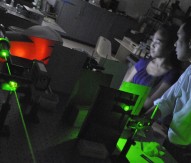
Ultra-short X-ray pulses sheds new light on electron knowledge
Pioneering X-ray experiments at the Technische Universität München (TUM) in Germany have provided scientists with a glimpse into the widely-unknown nano world.
New research involving ultra-short and extremely strong X-ray flashes, as produced by free-electron lasers, is allowing scientists to take ‘snapshots’ of the geometry of the tiniest structures, for example the arrangement of atoms in molecules. The study is part-funded by the European Research Council through a Starting Grant.
In an effort to enhance existing knowledge about the precise duration and intensity of the X-ray flashes so as to improve not only spatial but also temporal resolution, researchers at TUM, the Hamburg Center for Free-Electron Laser Science (CFEL) and the Max Planck Institute of Quantum Optics (MPQ), Germany, have determined the necessary duration of X-ray flashes by modifying a process originally developed to measure ultra-short flashes of light.
The physicists directed the X-ray flashes into a vacuum chamber filled with a few atoms of an inert gas, were they superimposed the flashes with 2.4 micrometre wavelength pulses of infrared light.
When the X-ray flashes hit a gas atom they knock electrons out of the innermost shell, freeing them. The electrons are then accelerated or decelerated by the electrical field of the infrared light pulse. The change in an electron’s velocity is a function of when the light intercepts the electron, and thus of the electrical field strength at the moment of ionisation.
Because electrons are freed during the full duration of an X-ray flash, electrons emitted at different points in time ‘feel’ different field strengths of the periodically oscillating infrared light. As a result, they are accelerated at varying rates.
From this, scientists are able to calculate the duration of the original X-ray flash from the different arrival times of the electrons in a detector.
Using this approach, the researchers determined that the average pulse duration doesn’t exceed four and a half femtoseconds (a millionth of a billionth of a second (10-15 seconds)).
In addition, the researchers obtained an insight into the structure of the X-ray flashes: a characteristic of the intense X-ray flashes generated in free-electron lasers is their randomly changing pulse form. A typical X-ray pulse comprises multiple contiguous shorter ‘X-ray spikes’. The number and intensity of these spikes varies from one shot to the next.
The researchers have managed to measure these ultra-short sub-peaks directly and thereby confirm predictions that the individual flashes last only around 800 attoseconds – (a billionth of a billionth of a second 10-18 seconds).
The new methodology allows the detailed, direct temporal measurement of X-ray pulses and augments methodologies for determining pulse shape and length indirectly from the structure of the electron packets used to generate the flashes.
The research has been published in Nature Photonics.






